Dealmaking in 2016: It’s Complicated
Pharm Exec convenes some of the industry’s top business development professionals and negotiators to talk about the current climate for biophamara dealmaking and the critical job of appraising new assets and their potential as market-worthy and transformative products for patients.
BIO reported a staggering 35,700 partnering meetings among its nearly 16,000 attendees at this summer’s annual convention in San Francisco. What was the subject matter for all these summits? To find out, Pharm Exec sat down with some of biopharma's top business development professionals who help mold the industry from the negotiating table.
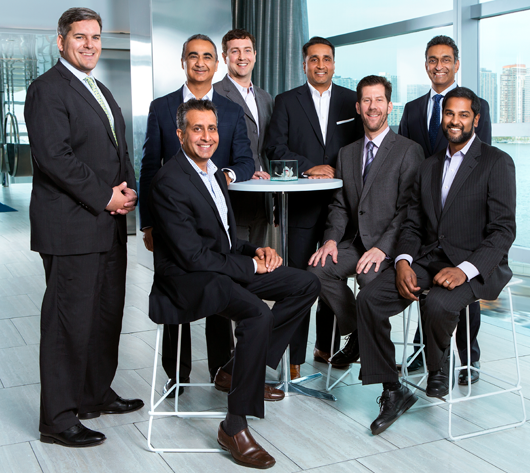
Photos: John Halpern
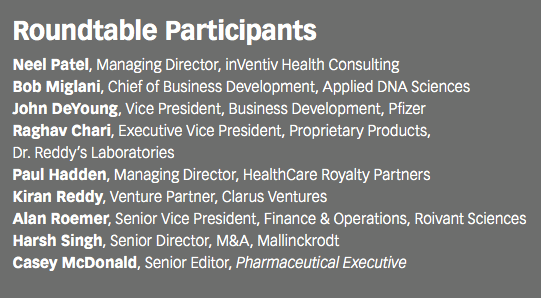
A new drug, whether it moves smoothly from the bench to bedside, or spends years idling on a big Pharma shelf, can be life-changing for patients. Appraising these assets and their market potential is the job of the dealmakers who bring disparate teams together to make scientific dreams a reality.
In its eighth year, the Dealmakers Intentions report, which gauges executives’ expectations for licensing and acquisition deals over the upcoming year, made a splash at the June BIO International Convention in San Francisco. In preparation for its final unveiling, inVentiv Health presented an early draft to Pharm Exec’s roundtable guests in May. Here, we present some highlights from the conversation.
PE: What’s the general outlook for dealmaking in 2016?
Neel Patel, inVentiv Health CONSULTING: Considering the IPO window as a marker for financing more broadly-that window may be not shut, but certainly closed a bit. It will be interesting to see if that’s sustained, but-and if we look at Q1 2016-it could still be a very robust year. Of course, the Q1 numbers might show a bit of a hangover period.
Paul Hadden, HealthCare Royalty Partners: From our vantage point as healthcare investors, the overall financing activity seems to be much slower this year. Coming out of the JP Morgan 2016 conference and certainly over the last several months since then, we see a lot more companies looking at alternative financing options. Looking back to JP Morgan 2015, capital of all forms seemed much more readily accessible. A lot has changed in a year.
Alan Roemer, Roivant Sciences: There are obviously fewer companies, but more importantly, I think the profile of the company has changed as well. Looking at the seven deals this year, we’re seeing much earlier-stage technologies, as opposed to the later stage. I think there are probably fewer, more traditional Phase II, Phase III-ready companies that are looking to go public at this point in time.
Patel: But the fact that they’re able to get out, even though they’re early stage, it still seems like there’s a healthy tolerance of risk, right? Maybe they’re not getting quite the price that they were hoping for, but they’re still getting out in the environment-and getting financed in an environment where things have soured is still a pretty positive
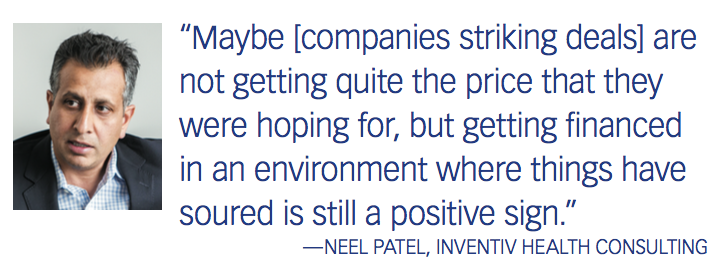
sign. In terms of M&A, there was just a deal announced, Stemcentrx for $9.8 billion, a private company, sort of unicorn. So 2016 still seems to be on track to be robust. In partnering deals, one thing to note is a steady decline of large pharma representation in the partnering and M&A. As we look around at the diaspora of talent that has occurred, there are a lot of individuals who come from big companies that have of moved on and are willing to take the chance and become senior members of commercial teams for these organizations. So that talent is helping enable them.
Harsh Singh, Mallinckrodt: If asking for the optimal point-when do I exit? There’s a theory that if I actually generate the dollar and show people and validate my technology platform, I will get more money; but there’s also a paradigm to that. If you go out and launch and it doesn’t do so well, or performs lower, that actually destroys a lot of value. You have to really identify exactly what you’re good at.
Raghav Chari, Dr. Reddy’s Laboratories: Right. I agree regarding the availability of the talent. Also, there’s a heck of a lot more data today to be able to do targeted commercialization, especially in the specialty arena. Marketing is a lot more scientific now. It’s less relationship-driven and much more science-driven, and I would suspect that a lot of teams have the confidence that they can make the most out of that product at this point with the talent that’s available. I think that you might be seeing a shift in the confidence levels of these parties, in terms of not falling flat on their face.
Patel: When we’re approached by clients who are going to commercialize, there’s almost sort of a bifurcation that I see. There are those that looked for a deal, weren’t able to get one done, and if they really have conviction in their asset, have to commercialize themselves and get to a commercial proof of concept, and then may be taken out by a larger entity. And then there are those that have a very compelling asset and they may have had the chance to license it out and retain those rights.
John DeYoung, Pfizer: It also relates to the scale of the opportunity and where its potential is. I think that Pharmacyclics worked a scenario where they’ve got a very strong oncology partner with J&J that was probably driving much of what was happening. Also, there’s kind of a moral imperative that if this is a drug that’s going to help cancer patients in a significant way, or whatever the disease is, do you want someone that’s never commercialized?
Kiran Reddy, Clarus Ventures: And certainly the other element of it is the credible threat of being able to launch the product. Often in orphan and specialty indications, no one has ever commercialized that product exactly like that before. So you have got to do all the work, if you were to justify even to sell,
Hadden: An example to point to is Kythera, who sold to Allergan in 2015 at a valuation in excess of $2 billion, without ever generating a dollar of sales. They clearly had a differentiated, newly FDA-approved product and were prepared to launch it on their own. At that point, the decision to sell versus launch to the investors was clear-but to get there they had to have that credible threat of launching on the product
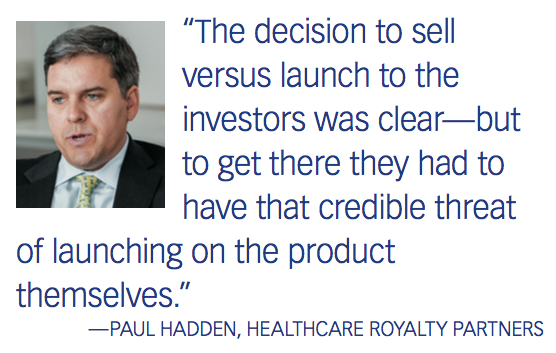
themselves.
Patel: Sometimes we get pulled in to help companies fill that credible threat-call it a head fake.
Hadden: From a financing perspective, we are interested to see how the rest of this year plays out. Despite the recent slowdown in the public markets, there are still a lot of firms who have a fair amount of cash on their balance sheet from the last two years of very accessible public markets. From an optionality perspective, companies may have some ability, at least in the near term, to choose to launch or sell and not be completely dependent on the public markets.
DeYoung: One dynamic that’s happening-speed is critical. The amount of competition in every area, particularly immuno-oncology, [is strong]. Can companies effectively compete? This is such a competitive space, and we’re talking with just generally IO companies. We’re hoping Phase I trials can be pivotal, and that if they’re not, you’re driving right into Phase III. My sense is, in oncology, for a hot area, there’s competition and there’s a need to be able to accelerate. Sometimes companies can do it on their own, but I think more and more folks are looking to companies with a kind of a breadth of IO experience-particularly with combinations.
Hadden: Specifically, the volume of science that’s coming out in oncology right now is quite significant and rapid. But what is striking is not just the pace of new science but also the sheer amount of capital that is flowing in to the field. Development strategies in this area are clearly different from, say, five years ago, with the observation that companies are moving much faster through the clinic.
PE: With so many new products and combinations, how complex are the scenarios being discussed at the deal table?
DeYoung: In the good old days, you do a model, and if you think about the duration of the drug through your LOE (loss of exclusivity), because of the volume of competition in certain areas, what is your product’s duration? How long are you going to be able to maintain this-what you think you’re going to capture?
It’s fantastic that so much is going on to affect cancer, but when you’re looking at opportunities, and saying, “here’s my typical model, this is the new benefit that I’m going to have, and we’re going to have this great return for X number of years,” it’s harder to sell that when people see the volume of activity that’s going on in all the various ways to affect different cancers. … The pace of innovation that’s happening, it’s hard to estimate.
Chari: I would agree, even outside of oncology. The impact of aggressive-managed efforts to manage and contain formularies is felt all the way down, where previously, you could fly below the radar in different scenarios. Now, they realize what you always knew to be true, which is you can’t write simple rules and manage entire categories based on rules.
We work in the dermatology segment, and among other products that we sell, we have topical steroids. United Healthcare took every brand of topical steroid off their formulary and will only reimburse generics. They are doing things like that to sort of change how reimbursement works, and that has a big impact across all categories. Obviously, it’s very complex in oncology, but even in categories where you’re talking about non-combination therapies, there’s a big impact, and as a buyer, you have to look at those factors and see how the dynamics are changing.
Bob Miglani, Applied DNA Sciences: Part of it is also the window. The pricing is one thing-you have an idea of what the estimated price is and to launch on this date-but you have to negotiate from country to country, from managed care to managed care. The next thing you know, another competitor comes out.
Hadden: You make a great point. When our firm is looking at purchasing a royalty stream with an eight to 10-year term, we look at a number of factors in trying to predict the future. Take the hepatitis C space as an example; when the first generation of protease inhibitors launched several years ago, it presented a very unique situation where we were able to accurately predict that those agents would be replaced by the next generation within five years-and that is a very fast and somewhat unprecedented time frame. But in looking at the second-generation orals, reimbursement was the major theme because a lot more market clout was exerted by payers.
Miglani: I’m on the board of a few companies-small companies-because of my pricing experience, and these companies have no clue. They don’t even have the semblance of data and reimbursement to analyze the support, and, so, pricing is one part of it, but then getting the reimbursement and then time-to-market.
Patel: Companies who aren’t getting an understanding of how managed care is going to look at their product well before it gets to the market are really taking a misstep-making sure that their secondary endpoints aren’t at least counted in their Phase III trial, because once the ingredients are mixed and the cake’s in the oven, you have no
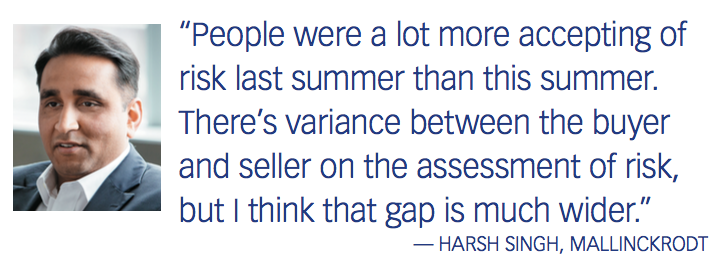
options. If you haven’t been thoughtful well in advance, you’re going to find yourself in trouble.
Singh: We’re talking about pricing. I think that conversation falls in line with comfort level. One of the things that might be tied in is threshold for risk. The big shift between the summer of 2015 and 2016 that you’re going to see is that the threshold for risk is very different than what it was. People were a lot more accepting of risk last summer than this summer. There’s variance between the buyer and seller on the assessment of risk, but I think that gap is much wider.
Roemer: For the transactions that are being done on the licensing and partnership side, how many people are still seeing the collaborative nature of licensing deals? Is the joint steering committee, three from each party, kind of guiding the development, or is this more, “Thank you very much, we’ll take it from here and we’ll move on?” Have you observed any changes in that over the last two years?
Singh: On the development side, no. It’s still collaborative. On the commercial side, market collaborations don’t work. On the developmental side, there’s some sharing and collaboration, and it might not be, “let’s co-develop.” Maybe one is better at regulatory and one is better on development, and so that’s how you collaborate on the science side. On the commercial side, I’ve seen it drift very heavily toward development.
Chari: In our case, the last three deals that we did all had joint committees, but that’s because the two parties had different geographic rights, so you had to collaborate. To Harsh’s point, as far as commercialization is concerned, I think the general consensus of all of us working in specialty areas is that the rationale to split a commercial effort doesn’t exist.
Singh: It’s all connected. Why do co-promotes not work? It’s because of pricing. What the marketing team does or the commercial team does is that everything is done through contracting now with managed care and group purchasing organizations and the whole supply chain from the wholesaler going through the whole system. That’s where the value of the price is. So the control of pricing is very important. You can’t have two separate entities doing it. It’s very segmented and involves different geographies. You need to have one person doing it with that central control and the leverage over your respective buyers, and that’s why co-promotes and co-marketing deals have kind of gone by the wayside.
PE: How do strategies change when looking for highly-sought-after assets vs. finding diamonds in the rough that no one else sees?
DeYoung: The business happens at scientific meetings. JP Morgan is an important meeting for everyone, but at AACR, ASCO, ESMO, ASH, people are meeting around the data. What’s hot in the scientific community ends up being hot in the business development aspects. It always feels like a seller’s market.
Chari: But I think some of that is an evaluation threshold artifact in the sense that if you’re looking for these billion-dollar blockbusters, you’re absolutely right. It’s different when you’re looking at smaller assets that have sales estimates in the $100 million to $200 million range. There’s a lot of noise, and one of the things that we look for are so-called diamonds in the rough.
We spend a lot of time examining the raw data of the acquisitions that we’re looking to make, and we look for signals that the companies who are developing them haven’t necessarily seen. That can give us conviction to link a development strategy for that product, to enable commercial value that is greater than what the companies who are selling it believe it to be.
Singh: That’s an interesting point, but what is it, specifically, that you are looking for? What signals? Is it the indications that are being de-risked now, or is it because you find multiple uses for the particular technology that are beyond what the company thinks?
Chari: There’s a flaw when one looks at assets that have failed, or haven’t done as well as the innovators thought they would in clinical studies, that one looks at the data as point estimates. We’ve found that you can learn far more about what that molecule is doing by looking at the data longitudinally. How individual patients are faring on the drug, which patients drop out early, how does the dropout have an impact on certain variables. And you need to marry your understanding of commercial potential to different hypotheses around clinical trial regimen, patient segments and product label scenarios. As long as you’re willing to wade through the raw data, you can discern those signals.
DeYoung: But the point is a valid one-that it’s critical, with any of these opportunities, that you’re looking at the raw data, because companies do their best to present their interpretation, and, sometimes, when you look at the case report forms, you would not code patients the same way, right?
From a portfolio management perspective, at some companies, whatever falls below the line, you put on the shelf. If it’s a study that falls below the line, we might go to Clarus for funding for that trial...curing cancer is a capital investment. Depending on how much capital you can put in something, we put it to where we think the greatest potential is in terms of affecting patients.
We’re not perfect in our decisions. We would prefer to put things on the shelf, because if these other drugs actually make it, then it’s embarrassing to us that we didn’t keep it. Whereas, we’ve made the decision that, in the end, we would rather have a portfolio that’s helping patients and that we’re getting a return from, and we think it’s short-sighted, frankly, to say we’re just going to shelve them.
Roemer: But those are the calls we like to take. That’s what our mission is, and we do think about our partners and helping them unlock the value from the pipeline when they may not otherwise be able to fully fund themselves for a broad variety of reasons. If we can continue the advancement of these programs for patient-centric reasons and share in the upside, we’ll take that capital and development risk to do it if we have the program.
PE: What are you seeing in terms of demand for different technology types and assets at different stages of development, given their indication?
Singh: One thing that is underlying all this is the role of regulation and why there’s more demand. You have the GAIN Act that pushes antibiotics, you have opioid reduction. Those things are up in demand, and on the far right, you’ve got other issues and topics that are impacting the supply. The bar has been lowered. Anti-infectives were an under-invested field for much of my career. They couldn’t get a dollar out there, and the reason was because the FDA said that you have to show efficacy over proven, tested drugs that are out there. Now the FDA has said that you just have to prove safety-comparative safety. That’s a huge difference. So what are they actually differentiating on now? If you take my antibiotics, you don’t have to stay two weeks in the hospital anymore; we’ll get you out in three days, but now it’s going to cost three times as much. That’s sort of the trade-off that we’re seeing.
Patel: And on the hospital side, there’s an incentive to now look for outcomes and reduce hospitalization and readmissions. They’re going to be measured against that. So it’s the confluence of the regulatory environment, the economics of the hospital, that’s making it a more lucrative space than it has been. As Harsh said, for most of our careers, it has laid fallow in terms of development. We’re seeing a very meaningful resurgence.
Singh: And then in hospital infections, CMS is making hospitals pay for those. That’s a huge focus. It was very underserved, so it’s a great investment opportunity. At the same time, it’s been so heavily invested now. Where’s the differentiation point from the rest of the field, if you can get in on it, as many assets did? There were folks like Alan identifying assets 10 years ago that came out of big Pharma, that big Pharma had given up on because it was just too long of a developmental process, and the science was good, but to prove efficacy was finicky, and the commercial opportunity was limited that it didn’t make sense. Now, the bar is lowered, and it doesn’t mean it’s a bad thing, but it just means that it’s easier to get your product in the market and let the market decide.
Chari: In the anti-infectives area, there is still a fundamental challenge in that people are worried about resistance, due to which it takes a very long time for an antibacterial to reach peak sales. In other therapeutic areas, where you might have gone three to five years to get to 70 to 80% of your peak sales, an antibacterial can take six or seven years to get there. I don’t think that is going to change, even if you have the pharmacoeconomic pieces; you still have this overriding concern around drug resistance that’s going to drive behaviors in terms of using older drugs first before using new ones.
DeYoung: Aren’t antibiotics hugely sales-intensive? Because you have to sell that every single time.
Singh: It’s very clinically-driven, and to your point, it’s what makes the space unique, is that you’re dealing with something that changes as resistance develops.
PE: What about development and dealmaking around vaccines?
Singh: Well, it’s in the news, and it’s apparent. Again, the hurdles were too high, the clinical risk was too strong; that’s pretty much the story of anti-infectives. If an epidemic hits, there’s ultimately attention and focus. Vaccine technology has been more accessible and cheaper, and the government is involved, too. They directly contract with your vaccine providers and technology providers. The risk is it can go away tomorrow. The government can cut funding for it.
PE: For example, Zika support could vanish tomorrow?
Singh: Absolutely.
Chari: Some interesting vouchers have come out of the government programs, and that’s a question for the bigger players, because that’s a different mechanism by which you can justify going after these types of niche conditions.
Singh: They need to have scale to go after the voucher, and you have to have scale and risk to go after vaccines before you do that.
Reddy: Clearly, the vouchers have worked on tropical disease and infectious disease, and then pediatric vouchers, as well, have been some interesting investments where those products are not actually commercially viable, but the voucher is far more valuable.
PE: What are some reasons why deals fail?
Patel: From the survey, the top two reasons contributing are the differing opinions of commercial potential and unreasonable term expectations.
DeYoung: I would say the No. 1 reason why deals don’t happen is because we have a different view of the tech value.
Singh: For me, it’s risk-assessment of risk. If you’re doing a portfolio for financial engineers, that’s different. But if you’re looking at an innovative asset, risk is the No. 1 thing.
DeYoung: In the world we’re in right now, it is really important that we are very open and transparent. Say you and I aren’t doing the deal on this one. We may not agree, but at least I know that partner I’m dealing with is transparent and is being honest with me.
PE: What are some factors in the general healthcare and/or political environment that shape your thinking?
Reddy: The orphan drug space has been a really nice area, from an investment perspective, because we have the pricing dynamics that allows for it. How much specialty drugs will be regulated and scrutinized is a major concern.
Roemer: The biggest challenge for us as an organization, as we grow, is talent, and I know that sounds cliche, but for us, it is extremely important. We work in an organization that prides itself on innovation, both in terms of the clinical development activities that we do, as well as the way we approach capital allocations of our precious dollars to ensure that we’re designing trials in a way that will present the greatest chance at success, or fail, and fail early, and fail cheaply. Finding ultra-high performers within the industry, and in some cases, outside of the industry, actually has been what has perhaps limited us, as much as finding good assets to develop.
Hadden: Given the long-term nature of many royalty investments, some of the shifts we have seen in areas of the payer landscape have given us pause, while others have clearly created some opportunities. Over the long term, though, we are still bullish on life sciences-we just are selective on the areas in which we focus.
Miglani: Payers are obviously putting the squeeze on a lot of us. You need friends, and you need advocates. People don’t take meetings! I worked quite a bit with, for example, ARP, a partner to Pfizer. But they wouldn’t take a meeting in their offices or in our offices. They wanted to meet in a hotel in Washington and not exchange business cards-“We’ll take your money, but we don’t want to be seen with you.”
It’s really tough, and the thing is, individually, yes, we want to have more treatments and more options and cures for diseases that all of us are suffering with, but when you don’t have that kind of a partnership because of the trust in society, it allows the politicians and policymakers to put greater pressure and screws on the system without any backlash, and that’s very dangerous. To me, as an advocate of the pharmaceutical industry, it’s scary and challenging.
Chari: The perspective that I get, having a parent company that’s a generic organization, is looking at how the landscape has shifted. We’re looking at pretty big changes happening on retail and wholesale, and that has very clear impact on margins on the other side of the industry, the generic side. I think the kind of consolidation that we’re seeing on the managed care and on the payer side, as well as the consolidation on the retail wholesale side, is starting to paint a potential future picture.
Eventually the guys that are going to win are the ones who own the relationship with the patient, because so much is commoditized. It’s clear this is the bet that most companies are making with new patient service models and digital health initiatives.
DeYoung: We’re all making decisions about what we’re going to develop, whether it’s our own assets or products we bring in, and we’re all concerned about whether we’re
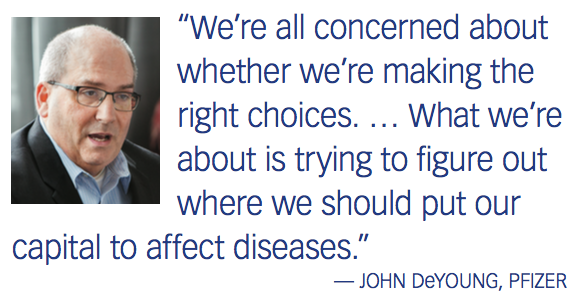
making the right choices. My next concern, or maybe hope, is given the environment, is the rhetoric playing to populism, or is something going to happen? Because if something happens, then we’re all going to have less capital to put at the work of trying to impact diseases.
You can pick some example of somebody that took a generic drug and raised the price by 1,000%. Those people, those charlatans, have been in every industry. What we’re about is trying to figure out where we should put our capital to affect diseases. That’s what I think about.
You look at other countries, use Canada as an example. Canada had a meaningful R&D infrastructure 20 years ago; it doesn’t anymore. Why? Well, there’s no funding of research. It’s all here. European companies, they’re all here to develop drugs. I’d like to see this environment continue.
Singh: What I worry about are the opportunities that are out there, and if there’s maybe some- one else in a better position. So is the business set up to be versatile? There’s just so much work to do and there’s not enough time. There’s a strategy to follow, where you invest your time. What else is out there? What are you missing? Are you prepared to handle change?
Casey McDonald is Pharm Exec’s Senior Editor. He can be reached at casey.mcdonald@ubm.com
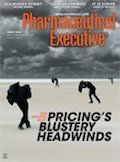
Novo Nordisk, The United Laboratories Ink Exclusive License Agreement for Triple Receptor Agonist
March 25th 2025Under terms of the license agreement, Novo Nordisk will acquire the rights to develop and commercialize UBT251 outside of China for obesity and type 2 diabetes for an upfront payment of $200 million.